United States dollar
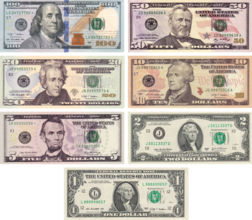 Federal Reserve Notes(obverse) | |
| ISO 4217 | |
|---|---|
| Code | USD (numeric:840) |
| Subunit | 0.01 |
| Unit | |
| Symbol | $,US$, U$ |
| Nickname | List
|
| Denominations | |
| Superunit | |
| 10 | Eagle |
| 100 | Union(Proposed, never issued) |
| Subunit | |
| 1⁄10 | Dime |
| 1⁄100 | Cent |
| 1⁄1000 | Mill |
| Symbol | |
| Cent | ¢ |
| Mill | ₥ |
| Banknotes | |
| Freq. used | $1,$5,$10,$20,$50,$100 |
| Rarely used | $2(still printed);$500,$1,000,$5,000,$10,000(discontinued, but still legal tender);$100,000(discontinued, not legal tender, and only used for specific purposes) |
| Coins | |
| Freq. used | 1¢,5¢,10¢,25¢ |
| Rarely used | 50¢,$1(still minted);1⁄2¢,2¢,3¢,20¢,$2.50,$3,$5,$10,$20(discontinued, but still legal tender) |
| Demographics | |
| Date of introduction | April 2, 1792[1] |
| Replaced | Continental currency Various foreign currencies, including: Pound sterling Spanish dollar |
| User(s) | see§ Formal users(11),§ Informal users(7) |
| Issuance | |
| Central bank | Federal Reserve |
| Website | federalreserve |
| Printer | Bureau of Engraving and Printing |
| Website | www |
| Mint | United States Mint |
| Website | usmint |
| Valuation | |
| Inflation | 3.0% or 2.6% |
| Source | BLS(June 2024) orBEA(May 2024) |
| Method | CPIorPCE |
| Pegged by | see§ Pegged currencies |
TheUnited States dollar(symbol:$;currency code:USD;also abbreviatedUS$to distinguish it fromother dollar-denominated currencies;referred to as thedollar,U.S. dollar,American dollar,or colloquiallybuck) is the officialcurrencyof theUnited Statesandseveral other countries.TheCoinage Act of 1792introduced the U.S. dollar at par with theSpanish silver dollar,divided it into 100cents,and authorized themintingof coins denominated in dollars and cents. U.S. banknotes are issued in the form ofFederal Reserve Notes,popularly called greenbacks due to their predominantly green color.
Themonetary policy of the United Statesis conducted by theFederal Reserve System,which acts as the nation'scentral bank.
The U.S. dollar was originally defined under abimetallic standardof 371.25 grains (24.057 g) (0.7735 troy ounces) fine silver or, from 1837, 23.22 grains (1.505 g) fine gold, or $20.67 pertroy ounce.TheGold Standard Actof 1900 linked the dollar solely to gold. From 1934, its equivalence to gold was revised to $35 pertroy ounce.In 1971 all links to gold were repealed.[2]
The U.S. dollar became an important internationalreserve currencyafter theFirst World War,and displaced thepound sterlingas the world's primary reserve currency by theBretton Woods Agreementtowards the end of theSecond World War.The dollar is themost widely used currencyininternational transactions,[3]and afree-floating currency.It is also theofficial currency in several countriesand thede factocurrencyin many others,[4][5]withFederal Reserve Notes(and, in a few cases, U.S. coins) used in circulation.
As of February 10, 2021, currency in circulation amounted toUS$2.10trillion,$2.05 trillionof which is in Federal Reserve Notes (the remaining$50 billionis in the form ofcoinsand older-styleUnited States Notes).[6]
As of September 20, 2023, the Federal Reserve estimated that the total amount of currency in circulation was approximatelyUS$2.33trillion.[7]
Overview[edit]
In the Constitution[edit]
Article I,Section 8of theU.S. Constitutionprovides thatCongresshas the power "[t]ocoin money."[8]Laws implementing this power are currently codified inTitle 31of theU.S. Code,under Section 5112, which prescribes the forms in which the United States dollars should be issued.[9]These coins are both designated in the section as "legal tender"in payment of debts.[9]TheSacagawea dollaris one example of thecopper alloydollar, in contrast to theAmerican Silver Eaglewhich is puresilver.Section 5112 also provides for themintingandissuanceof other coins, which have values ranging fromone cent(U.S. Penny) to 100 dollars.[9]These other coins are more fully described inCoins of the United States dollar.
Article I, Section 9of the Constitution provides that "a regular Statement and Account of the Receipts and Expenditures of all public Money shall be published from time to time",[10]which is further specified by Section 331 of Title 31 of the U.S. Code.[11]The sums of money reported in the "Statements" are currently expressed in U.S. dollars, thus the U.S. dollar may be described as theunit of accountof the United States.[12]"Dollar" is one of the first words of Section 9, in which the term refers to theSpanish milled dollar,or the coin worth eightSpanish reales.
Coinage Act[edit]
In 1792, theU.S. Congresspassed theCoinage Act,of which Section 9 authorized the production of various coins, including:[13]: 248
Dollars or Units—each to be of the value of a Spanish milled dollar as the same is now current, and to contain three hundred and seventy-onegrainsand four sixteenth parts of a grain of pure, or four hundred and sixteen grains of standard silver.
Section 20 of the Act designates the United States dollar as theunit of currencyof the United States:[13]: 250–1
[T]he money of account of the United States shall be expressed in dollars, or units...and that all accounts in the public offices and all proceedings in the courts of the United States shall be kept and had in conformity to this regulation.
Decimal units[edit]
Unlike the Spanish milled dollar, theContinental Congressand the Coinage Act prescribed adecimal systemof units to go with the unit dollar, as follows:[14][15]themill,or one-thousandth of a dollar; thecent,or one-hundredth of a dollar; thedime,or one-tenth of a dollar; and theeagle,or ten dollars. The current relevance of these units:
- Only thecent(¢) is used as everyday division of the dollar.
- Thedimeis used solely as the name of thecoinwith the value of 10 cents.
- Themill(₥) is relatively unknown, but before the mid-20th century was familiarly used in matters ofsales taxes,as well asgasoline prices,which are usually in the form of $ΧΧ.ΧΧ9 pergallon(e.g., $3.599, commonly written as $3.59+9⁄10).[16][17]
- Theeagleis also largely unknown to the general public.[17]This term was used in theCoinage Act of 1792for the denomination of ten dollars, and subsequently was used in naming gold coins.
TheSpanish peso or dollarwas historically divided into eightreales(colloquially,bits) – hencepieces of eight.Americans also learned counting in non-decimalbitsof12+1⁄2cents before 1857 when Mexicanbitswere more frequently encountered than American cents; in fact this practice survived inNew York Stock Exchangequotations until 2001.[18][19]
In 1854,Secretary of the TreasuryJames Guthrieproposed creating $100, $50, and $25 gold coins, to be referred to as aunion,half union,andquarter union,respectively,[20]thus implying a denomination of 1 Union = $100. However, no such coins were ever struck, and only patterns for the $50 half union exist.
When currently issued in circulating form, denominations less than or equal to a dollar are emitted asU.S. coins,while denominations greater than or equal to a dollar are emitted asFederal Reserve Notes,disregarding these special cases:
- Gold coins issued forcirculationuntil the 1930s, up to the value of $20 (known as thedouble eagle)
- Bullion or commemorativegold,silver,platinum,andpalladium coinsvalued up to $100 as legal tender (though worth far more asbullion).
- Civil War paper currency issue in denominations below $1, i.e. fractional currency, sometimes pejoratively referred to asshinplasters.
Etymology[edit]
In the 16th century, CountHieronymus SchlickofBohemiabegan minting coins known asjoachimstalers,named forJoachimstal,the valley in which the silver was mined. In turn, the valley's name is titled afterSaint Joachim,wherebythalortal,a cognate of the English worddale,isGermanfor 'valley.'[21]Thejoachimstalerwas later shortened to the Germantaler,a word that eventually found its way into many languages, including:[21] tolar(Czech,SlovakandSlovenian);daler(DanishandSwedish); dalaranddaler(Norwegian);dalerordaalder(Dutch); talari(Ethiopian); tallér(Hungarian); tallero(Italian); دولار(Arabic); anddollar(English).
Though theDutchpioneered in modern-dayNew Yorkin the 17th century the use and the counting of money in silver dollars in the form of German-Dutchreichsthalersand native Dutchleeuwendaalders('lion dollars'), it was the ubiquitousSpanish Americaneight-real coinwhich became exclusively known as thedollarsince the 18th century.[22]
Nicknames[edit]
Thecolloquialismbuck(s)(much like the Britishquidfor thepound sterling) is often used to refer to dollars of various nations, including the U.S. dollar. This term, dating to the 18th century, may have originated with the colonialleathertrade, or it may also have originated from apokerterm.[23]
Greenbackis another nickname, originally applied specifically to the 19th-centuryDemand Notedollars, which were printed black and green on the backside, created byAbraham Lincolnto finance theNorthfor theCivil War.[24]It is still used to refer to the U.S. dollar (but not to the dollars of other countries). The termgreenbackis also used by the financial press in other countries, such as Australia,[25]New Zealand,[26]South Africa,[27]andIndia.[28]
Other well-known names of the dollar as a whole in denominations includegreenmail,green,anddead presidents,the latter of which referring to the deceased presidents pictured on most bills. Dollars in general have also been known asbones(e.g. "twenty bones" = $20). The newer designs, with portraits displayed in the main body of the obverse (rather than incameoinsets), upon paper color-coded by denomination, are sometimes referred to asbigfacenotes orMonopolymoney.[citation needed]
Piastrewas the original French word for the U.S. dollar, used for example in the French text of theLouisiana Purchase.Though the U.S. dollar is calleddollarin Modern French, the termpiastreis still used among the speakers ofCajun FrenchandNew England French,as well as speakers inHaitiand otherFrench-speaking Caribbeanislands.
Nicknames specific to denomination:
- Thequarter dollarcoin is known astwo bits,alluding the dollar's origins as the "piece of eight" (bits orreales).[18]
- The$1 billis nicknamedbuckorsingle.
- The infrequently-used$2 billis sometimes calleddeuce,Tom,orJefferson(afterThomas Jefferson).
- The$5 billis sometimes calledLincoln(afterAbraham Lincoln),fin,fiver,orfive-spot.
- The$10 billis sometimes calledsawbuck,ten-spot,orHamilton(afterAlexander Hamilton).
- The$20 billis sometimes calleddouble sawbuck,Jackson(afterAndrew Jackson), ordouble eagle.
- The$50 billis sometimes called ayardstick,or agrant,after PresidentUlysses S. Grant.
- The$100 billis calledBenjamin,Benji,Ben,orFranklin,referring to its portrait ofBenjamin Franklin.Other nicknames includeC-note(C being theRoman numeralfor 100),century note,orbill(e.g.two bills= $200).
- Amounts or multiples of $1,000 are sometimes calledgrandin colloquial speech, abbreviated in written form toG,K,ork(fromkilo;e.g. $10k = $10,000). Likewise, alargeorstackcan also refer to a multiple of $1,000 (e.g. "fifty large" = $50,000).
Dollar sign[edit]
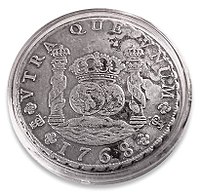
The symbol$,usually written before the numerical amount, is used for the U.S. dollar (as well as for many other currencies). The sign was the result of a late 18th-century evolution of thescribal abbreviationpsfor thepeso,the common name for theSpanish dollarsthat were in wide circulation in theNew Worldfrom the 16th to the 19th centuries. Thepand theseventually came to be written over each other giving rise to$.[29][30][31][32]
Another popular explanation is that it is derived from thePillars of Herculeson theSpanish Coat of armsof theSpanish dollar.ThesePillars of Herculeson the silver Spanish dollar coins take the form of two vertical bars (||) and a swinging cloth band in the shape of anS.[citation needed]
Yet another explanation suggests that the dollar sign was formed from the capital lettersUandSwritten or printed one on top of the other. This theory, popularized by novelistAyn RandinAtlas Shrugged,[33]does not consider the fact that the symbol was already in use before the formation of the United States.[34]
History[edit]
Origins: the Spanish dollar[edit]
The U.S. dollar was introduced at par with the Spanish-Americansilver dollar(orSpanish peso,Spanish milled dollar,eight-real coin,piece-of-eight). The latter was produced from the rich silver mine output ofSpanish America,was minted inMexico City,Potosí(Bolivia),Lima(Peru), and elsewhere, and was in wide circulation throughout the Americas, Asia, and Europe from the 16th to the 19th centuries. The minting of machine-milled Spanish dollars since 1732 boosted its worldwide reputation as a trade coin and positioned it to be the model for the new currency of theUnited States.[citation needed]
Even after theUnited States Mintcommenced issuing coins in 1792, locally minteddollarsandcentswere less abundant in circulation thanSpanish Americanpesosandreales;hence Spanish, Mexican, and American dollars all remained legal tender in the United States until theCoinage Act of 1857.In particular, colonists' familiarity with the Spanish two-real quarter pesowas the reason for issuing a quasi-decimal25-cent quarter dollar coinrather than a 20-cent coin.[citation needed]
For the relationship between theSpanish dollarand the individual state colonial currencies, seeConnecticut pound,Delaware pound,Georgia pound,Maryland pound,Massachusetts pound,New Hampshire pound,New Jersey pound,New York pound,North Carolina pound,Pennsylvania pound,Rhode Island pound,South Carolina pound,andVirginia pound.[citation needed]
Coinage Act of 1792[edit]

On July 6, 1785, theContinental Congressresolved that the money unit of the United States, the dollar, would contain 375.64grainsof fine silver; on August 8, 1786, the Continental Congress continued that definition and further resolved that the money of account, corresponding with the division of coins, would proceed in adecimal ratio,with the sub-units being mills at 0.001 of a dollar, cents at 0.010 of a dollar, and dimes at 0.100 of a dollar.[14]
After the adoption of theUnited States Constitution,the U.S. dollar was defined by theCoinage Act of 1792.It specified a "dollar" based on theSpanish milled dollarto contain371+4⁄16grainsof fine silver, or 416.0 grains (26.96 g) of "standard silver" of fineness 371.25/416 = 89.24%; as well as an "eagle" to contain247+4⁄8grains of fine gold, or 270.0 grains (17.50 g) of 22karator 91.67% fine gold.[35]Alexander Hamiltonarrived at these numbers based on a treasury assay of the average fine silver content of a selection of wornSpanish dollars,which came out to be 371 grains. Combined with the prevailing gold-silver ratio of 15, the standard for gold was calculated at 371/15 = 24.73 grains fine gold or 26.98 grains 22K gold. Rounding the latter to 27.0 grains finalized the dollar's standard to 24.75 grains of fine gold or 24.75*15 = 371.25 grains = 24.0566 grams = 0.7735 troy ounces of fine silver.
The same coinage act also set the value of an eagle at 10 dollars, and the dollar at1⁄10eagle. It called for silver coins in denominations of 1,1⁄2,1⁄4,1⁄10,and1⁄20dollar, as well as gold coins in denominations of 1,1⁄2and1⁄4eagle. The value of gold or silver contained in the dollar was then converted into relative value in the economy for the buying and selling of goods. This allowed the value of things to remain fairly constant over time, except for the influx and outflux of gold and silver in the nation's economy.[36]
Though aSpanish dollarfreshly minted after 1772 theoretically contained 417.7 grains of silver of fineness 130/144 (or 377.1 grains fine silver), reliable assays of the period in fact confirmed a fine silver content of 370.95 grains (24.037 g) for the average Spanish dollar in circulation. [37] The new U.S. silver dollar of 371.25 grains (24.057 g) therefore compared favorably and was received at par with the Spanish dollar for foreign payments, and after 1803 theUnited States Minthad to suspend making this coin out of its limited resources since it failed to stay in domestic circulation. It was only after Mexican independence in 1821 when their peso's fine silver content of 377.1 grains was firmly upheld, which the U.S. later had to compete with using a heavier 378.0 grains (24.49 g)Trade dollar coin.
Design[edit]
The early currency of the United States did not exhibit faces of presidents, as is the custom now;[38]although today, by law, only the portrait of a deceased individual may appear on United States currency.[39]In fact, the newly formed government was against having portraits of leaders on the currency, a practice compared to the policies of European monarchs.[40]The currency as we know it today did not get the faces they currently have until after the early 20th century; before that "heads" side of coinage used profile faces and striding, seated, and standing figures from Greek and Roman mythology and composite Native Americans. The last coins to be converted to profiles of historic Americans were the dime (1946), the half Dollar (1948), and the Dollar (1971).
Continental currency[edit]

After theAmerican Revolution,theThirteen Coloniesbecameindependent.Freed from British monetary regulations, they each issued£sdpaper money to pay for military expenses. TheContinental Congressalso began issuing "Continental Currency" denominated in Spanish dollars. For its value relative to states' currencies, seeEarly American currency.
Continental currencydepreciatedbadly during the war, giving rise to the famous phrase "not worth a continental".[41]A primary problem was that monetary policy was not coordinated between Congress and the states, which continued to issue bills of credit. Additionally, neither Congress nor the governments of the several states had the will or the means to retire the bills from circulation through taxation or the sale of bonds.[42]The currency was ultimately replaced by the silver dollar at the rate of 1 silver dollar to 1000 continental dollars. This resulted in the clause "No state shall... make anything but gold and silver coin a tender in payment of debts" being written into theUnited States Constitution article 1, section 10.
Silver and gold standards, 19th century[edit]
From implementation of the 1792Mint Actto the 1900 implementation of thegold standard,the dollar was on abimetallicsilver-and-gold standard, defined as either 371.25grains(24.056 g) of fine silver or 24.75 grains of fine gold (gold-silver ratio 15).
Subsequent to theCoinage Act of 1834the dollar's fine gold equivalent was revised to 23.2 grains; it was slightly adjusted to 23.22 grains (1.505 g) in 1837 (gold-silver ratio ~16). The same act also resolved the difficulty in minting the "standard silver" of 89.24% fineness by revising the dollar's alloy to 412.5 grains, 90% silver, still containing 371.25 grains fine silver. Gold was also revised to 90% fineness: 25.8 grains gross, 23.22 grains fine gold.
Following the rise in the price of silver during theCalifornia Gold Rushand the disappearance of circulating silver coins, theCoinage Act of 1853reduced the standard for silver coins less than $1 from 412.5 grains to 384 grains (24.9 g), 90% silver per 100 cents (slightly revised to 25.0 g, 90% silver in 1873). The Act also limited thefree silverright of individuals to convertbullioninto only one coin, the silver dollar of 412.5 grains; smaller coins of lower standard can only be produced by theUnited States Mintusing its own bullion.
Summary andlinks to coinsissued in the 19th century:
- In base metal:1/2 cent,1 cent,5 cents.
- In silver:half dime,dime,quarter dollar,half dollar,silver dollar.
- In gold:gold $1,$2.50 quarter eagle,$5 half eagle,$10 eagle,$20 double eagle.
- Less common denominations:bronze 2 cents,nickel 3 cents,silver 3 cents,silver 20 cents,gold $3.
Note issues, 19th century[edit]

In order to finance theWar of 1812,Congress authorized the issuance ofTreasury Notes,interest-bearing short-term debt that could be used to pay public dues. While they were intended to serve as debt, they did function "to a limited extent" as money. Treasury Notes were again printed to help resolve the reduction in public revenues resulting from thePanic of 1837and thePanic of 1857,as well as to help finance theMexican–American Warand theCivil War.
Paper money was issued again in 1862 without the backing of precious metals due to theCivil War.In addition to Treasury Notes, Congress in 1861 authorized the Treasury to borrow $50 million in the form ofDemand Notes,which did not bear interest but could be redeemed on demand for precious metals. However, by December 1861, theUniongovernment's supply of specie was outstripped by demand for redemption and they were forced to suspend redemption temporarily. In February 1862 Congress passed theLegal Tender Act of 1862,issuingUnited States Notes,which were not redeemable on demand and bore no interest, but werelegal tender,meaning that creditors had to accept them at face value for any payment except for public debts and import tariffs. However, silver and gold coins continued to be issued, resulting in the depreciation of the newly printed notes throughGresham's Law.In 1869, Supreme Court ruled inHepburn v. Griswoldthat Congress could not require creditors to accept United States Notes, but overturned that ruling the next year in theLegal Tender Cases.In 1875, Congress passed theSpecie Payment Resumption Act,requiring the Treasury to allow U.S. Notes to be redeemed for gold after January 1, 1879.
Gold standard, 20th century[edit]
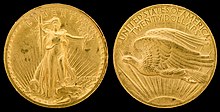
Though the dollar came under thegold standardde jureonly after 1900, thebimetallic erawas endedde factowhen theCoinage Act of 1873suspended the minting of the standardsilver dollarof 412.5 Troygrains= 26.73 g; 0.859 ozt, the only fully legal tender coin that individuals could convert bullion into in unlimited (orFree silver) quantities,[a]and right at the onset of thesilver rushfrom theComstock Lodein the 1870s. This was the so-called "Crime of '73".
TheGold Standard Actof 1900 repealed the U.S. dollar's historic link to silver and defined it solely as 23.22 grains (1.505 g) of fine gold (or $20.67 pertroy ounceof 480 grains). In 1933, gold coins were confiscated byExecutive Order 6102underFranklin D. Roosevelt,and in 1934 the standard was changed to $35 per troy ounce fine gold, or 13.71 grains (0.888 g) per dollar.
After 1968 a series of revisions to the gold peg was implemented, culminating in theNixon Shockof August 15, 1971, which suddenly ended the convertibility of dollars to gold. The U.S. dollar has since floated freely on theforeign exchange markets.[citation needed]
Federal Reserve Notes, 20th century to present[edit]
Congress continued to issue paper money after the Civil War, the latest of which is theFederal Reserve Notethat was authorized by theFederal Reserve Act of 1913.Since the discontinuation of all other types of notes (Gold Certificates in 1933, Silver Certificates in 1963, and United States Notes in 1971), U.S. dollar notes have since been issued exclusively asFederal Reserve Notes.
Emergence as reserve currency[edit]
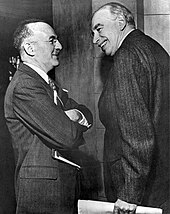
The U.S. dollar first emerged as an important internationalreserve currencyin the 1920s, displacing the Britishpound sterlingas it emerged from theFirst World Warrelatively unscathed and since the United States was a significant recipient of wartime gold inflows. After the United States emerged as an even stronger globalsuperpowerduring theSecond World War,theBretton Woods Agreementof 1944 established the U.S. dollar as the world's primary reserve currency and the only post-war currency linked to gold. Despite all links to gold being severed in 1971, the dollar continues to be the world's foremost reserve currency for international trade to this day.
The Bretton Woods Agreement of 1944 also defined the post-World War II monetary order and relations among modern-dayindependent states,by setting up a system of rules, institutions, and procedures to regulate theinternational monetary system.The agreement founded theInternational Monetary Fundand other institutions of the modern-dayWorld Bank Group,establishing the infrastructure for conducting international payments and accessing the global capital markets using the U.S. dollar.
Themonetary policy of the United Statesis conducted by theFederal Reserve System,which acts as the nation'scentral bank.It was founded in 1913 under theFederal Reserve Actin order to furnish an elastic currency for the United States and to supervise its banking system, particularly in the aftermath of thePanic of 1907.
For most of the post-war period, theU.S. governmenthas financed its own spending by borrowing heavily from the dollar-lubricated global capital markets, in debts denominated in its own currency and at minimal interest rates. This ability to borrow heavily without facing a significantbalance of payments crisishas been described as theUnited States'sexorbitant privilege.
Coins[edit]
TheUnited States Minthas issued legal tender coins every year from 1792 to the present. From 1934 to the present, the only denominations produced for circulation have been the familiar penny, nickel, dime, quarter, half dollar, and dollar.
| Denomination | Common name | Obverse | Reverse | Obverse portrait and design date | Reverse motif and design date | Weight | Diameter | Material | Edge | Circulation |
|---|---|---|---|---|---|---|---|---|---|---|
| Cent 1¢ |
penny | Abraham Lincoln(1909) | Union Shield (2010) | 2.5 g (0.088 oz) |
0.75 in (19.05 mm) |
97.5%Zncovered by 2.5%Cu | Plain | Wide | ||
| Five cents 5¢ |
nickel | 
|
Thomas Jefferson(2006) | Monticello(1938) | 5.0 g (0.176 oz) |
0.835 in (21.21 mm) |
75% Cu 25%Ni |
Plain | Wide | |
| Ten cents 10¢ |
dime | Franklin D. Roosevelt(1946) | Olive branch,torch,andoak branch(1946) | 2.268 g (0.08 oz) |
0.705 in (17.91 mm) |
91.67% Cu 8.33% Ni |
118 reeds | Wide | ||
| Quarter dollar 25¢ |
quarter | 
|

|
George Washington(1932) | Various(5 designs per year) | 5.67 g (0.2 oz) |
0.955 in (24.26 mm) |
91.67% Cu 8.33% Ni |
119 reeds | Wide |
| Half dollar 50¢ |
half dollar | 
|

|
John F. Kennedy(1964) | Presidential Seal(1964) | 11.34 g (0.4 oz) |
1.205 in (30.61 mm) |
91.67% Cu 8.33% Ni |
150 reeds | Limited |
| Dollar coin $1 |
dollar coin, golden dollar | 
|

|
Sacagawea
(2000) |
Various(4 designs per year) | 8.10 g (0.286 oz) |
1.043 in (26.50 mm) |
88.5% Cu 6% Zn 3.5%Mn 2% Ni |
Plain 2000–2006 Lettered 2007–Present |
Limited |
| These images are to scale at 2.5 pixels per millimetre. For table standards, see thecoin specification table. | ||||||||||
Gold and silver coins have been previously minted for general circulation from the 18th to the 20th centuries. The last gold coins were minted in 1933. The last 90% silver coins were minted in 1964, and the last 40% silver half dollar was minted in 1970.
TheUnited States Mintcurrently produces circulating coins at thePhiladelphiaandDenver Mints,and commemorative and proof coins for collectors at theSan FranciscoandWest Point Mints.Mint mark conventions for these and for past mint branches are discussed inCoins of the United States dollar#Mint marks.
Theone-dollar coinhas never been in popular circulation from 1794 to present, despite several attempts to increase their usage since the 1970s, the most important reason of which is the continued production and popularity of theone-dollar bill.[43]Half dollar coinswere commonly used currency since inception in 1794, but has fallen out of use from the mid-1960s when all silver half dollars began to be hoarded.
Thenickelis the only coin whose size and composition (5 grams, 75% copper, and 25% nickel) is still in use from 1865 to today, except for wartime 1942–1945Jefferson nickelswhich contained silver.
Due to the penny's low value, someefforts have been made to eliminate the pennyas circulating coinage. [44][45]
For a discussion of other discontinued and canceled denominations, seeObsolete denominations of United States currencyandCanceled denominations of United States currency.
Collector coins[edit]
Collector coins are technically legal tender at face value but are usually worth far more due to their numismatic value or for their precious metal content. These include:
- American Eagle bullion coins
- American Silver Eagle$1 (1troy oz) Silver bullion coin 1986–present
- American Gold Eagle$5 (1⁄10troy oz), $10 (1⁄4troy oz), $25 (1⁄2troy oz), and $50 (1 troy oz) Gold bullion coin 1986–present
- American Platinum Eagle$10 (1⁄10troy oz), $25 (1⁄4troy oz), $50 (1⁄2troy oz), and $100 (1 troy oz) Platinum bullion coin 1997–present
- American Palladium Eagle$25 (1 troy oz) Palladium bullion coin 2017–present
- United States commemorative coins—special issue coins, among these:
- $50.00 (Half Union)minted for thePanama-Pacific International Exposition (1915)
- Silver proof sets minted since 1992 with dimes, quarters and half-dollars made of silver rather than the standard copper-nickel
- Presidential dollar coinsproof sets minted since 2007
Banknotes[edit]
| Denomination | Front | Reverse | Portrait | Reverse motif | First series | Latest series | Circulation |
|---|---|---|---|---|---|---|---|
| One dollar | 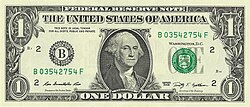
|

|
George Washington | Great Seal of the United States | Series 1963[b] Series 1935[c] |
Series 2021[46] | Wide |
| Two dollars | 
|

|
Thomas Jefferson | Declaration of IndependencebyJohn Trumbull | Series 1976 | Series 2017A | Limited[47] |
| Five dollars | 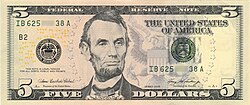
|
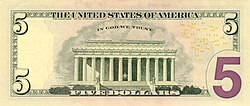
|
Abraham Lincoln | Lincoln Memorial | Series 2006 | Series 2021[48] | Wide |
| Ten dollars | 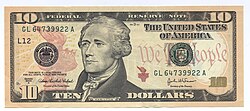
|
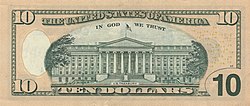
|
Alexander Hamilton | Treasury Building | Series 2004A | Series 2017A | Wide |
| Twenty dollars | 
|
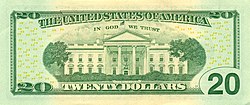
|
Andrew Jackson | White House | Series 2004 | Series 2017A | Wide |
| Fifty dollars | 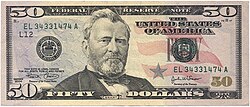
|
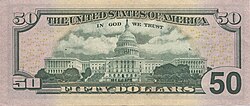
|
Ulysses S. Grant | United States Capitol | Series 2004 | Series 2017A | Wide |
| One hundred dollars | 
|

|
Benjamin Franklin | Independence Hall | Series 2009A[49] | Series 2017A | Wide |
TheU.S. Constitutionprovides that Congress shall have the power to "borrow money on the credit of the United States."[50]Congress has exercised that power by authorizingFederal Reserve Banksto issueFederal Reserve Notes.Those notes are "obligations of the United States" and "shall be redeemed in lawful money on demand at the Treasury Department of the United States, in the city of Washington, District of Columbia, or at any Federal Reserve bank".[51]Federal Reserve Notes are designated by law as "legal tender"for the payment of debts.[52]Congress has also authorized the issuance ofmore than 10 other types of banknotes,including theUnited States Note[53]and theFederal Reserve Bank Note.The Federal Reserve Note is the only type that remains in circulation since the 1970s.Federal Reserve Notesare printed by theBureau of Engraving and Printingand are made fromcotton fiber paper(as opposed towood fiberused to make common paper). The "large-sized notes"issued before 1928 measured 7.42 in × 3.125 in (188.5 mm × 79.4 mm), whilesmall-sized notesintroduced that year measure 6.14 in × 2.61 in × 0.0043 in (155.96 mm × 66.29 mm × 0.11 mm).[54]The dimensions of the modern (small-size) U.S. currency is identical to the size ofPhilippine pesobanknotes issued under United States administration after 1903, which had proven highly successful.[55]The American large-note bills became known as "horse blankets" or "saddle blankets".[56]
Currently printed denominations are$1,$2,$5,$10,$20,$50,and$100.Notes above the $100 denomination stopped being printed in 1946 and were officially withdrawn from circulation in 1969. These notes were used primarily in inter-bank transactions or byorganized crime;it was the latter usage that prompted PresidentRichard Nixonto issue an executive order in 1969 halting their use. With the advent of electronic banking, they became less necessary. Notes in denominations of $500, $1,000, $5,000, $10,000, and $100,000 were all produced at one time; seelarge denomination bills in U.S. currencyfor details. With the exception of the $100,000 bill (which was only issued as a Series 1934 Gold Certificate and was never publicly circulated; thus it is illegal to own), these notes are now collectors' items and are worth more than their face value to collectors.
Though still predominantly green, the post-2004 series incorporate other colors to better distinguish different denominations. As a result of a 2008 decision in an accessibility lawsuit filed by theAmerican Council of the Blind,theBureau of Engraving and Printingis planning to implement a raised tactile feature in the next redesign of each note, except the $1 and the current version of the $100 bill. It also plans larger, higher-contrast numerals, more color differences, and distribution of currency readers to assist the visually impaired during the transition period.[d]
Countries that use US dollar[edit]
Formal users[edit]
 United States
United States
- including 5 territories:
- United States Minor Outlying Islands
- Compact of Free Association
 East Timor[57],alongsideEast Timor centavo coins
East Timor[57],alongsideEast Timor centavo coins Ecuador[58],alongsideEcuadorian centavo coins
Ecuador[58],alongsideEcuadorian centavo coins El Salvador[59],alongsideBitcoin
El Salvador[59],alongsideBitcoin Liberia[60],alongsideLiberian dollar
Liberia[60],alongsideLiberian dollar Panama,alongsidePanamanian balboa
Panama,alongsidePanamanian balboa- British Overseas Territoriesbelonging to theUnited Kingdom of Great Britain and Northern Ireland:
- In theCaribbean Netherlands,part of theKingdom of the Netherlands:
Informal users[edit]
 Argentina[61],official currency isArgentine peso
Argentina[61],official currency isArgentine peso Cambodia[62][63],alongsideCambodian riel
Cambodia[62][63],alongsideCambodian riel Venezuela,alongsideVenezuelan Bolivar[64][65]
Venezuela,alongsideVenezuelan Bolivar[64][65] Zimbabwe,alongsideGold
Zimbabwe,alongsideGold- British Overseas Territoriesbelonging to theUnited Kingdom of Great Britain and Northern Ireland:
 British Indian Ocean Territory,official currency isPound sterling
British Indian Ocean Territory,official currency isPound sterling
- In theCaribbean Netherlands,part of theKingdom of the Netherlands:
 Sint Maarten,official currency isNetherlands Antillean guilder
Sint Maarten,official currency isNetherlands Antillean guilder
 Saint Martin(overseas collectivity,an integral part ofFrance) - official currency is Euro
Saint Martin(overseas collectivity,an integral part ofFrance) - official currency is Euro Honduras,official currency isHonduran lempira[66]
Honduras,official currency isHonduran lempira[66]
Monetary policy[edit]
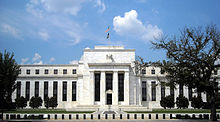
TheFederal Reserve Actcreated theFederal Reserve Systemin 1913 as thecentral bankof theUnited States.Its primary task is to conduct the nation'smonetary policyto promote maximum employment, stable prices, and moderate long-term interest rates in the U.S. economy. It is also tasked to promote the stability of the financial system and regulate financial institutions, and to act aslender of last resort.[67][68]
TheMonetary policy of the United Statesis conducted by theFederal Open Market Committee,which is composed of theFederal Reserve Board of Governorsand 5 out of the 12 Federal Reserve Bank presidents, and is implemented by all twelve regionalFederal Reserve Banks.
Monetary policyrefers to actions made by central banks that determine the size and growth rate of themoney supplyavailable in the economy, and which would result in desired objectives like low inflation, low unemployment, and stable financial systems. The economy's aggregatemoney supplyis the total of
- M0 money, or Monetary Base– "dollars" in currency andbank moneybalances credited to the central bank's depositors, which are backed by the central bank's assets,
- plus M1, M2, M3 money– "dollars" in the form ofbank moneybalances credited to banks' depositors, which are backed by the bank's assets and investments.
The FOMC influences the level of money available to the economy by the following means:
- Reserve requirements– specifies a required minimum percentage of deposits in acommercial bankthat should be held as a reserve (i.e. as deposits with the Federal Reserve), with the rest available to loan or invest. Higher requirements mean less money loaned or invested, helping keep inflation in check. Raising thefederal funds rateearned on those reserves also helps achieve this objective.
- Open market operations– the Federal Reserve buys or sellsUS Treasury bondsand other securities held by banks in exchange for reserves; more reserves increase a bank's capacity to loan or invest elsewhere.
- Discount window lending– banks can borrow from the Federal Reserve.
Monetary policydirectly affects interest rates; it indirectly affects stock prices, wealth, and currency exchange rates. Through these channels, monetary policy influences spending, investment, production, employment, and inflation in the United States. Effectivemonetary policycomplementsfiscal policyto support economic growth.
The adjusted monetary base has increased from approximately $400 billion in 1994, to $800 billion in 2005, and to over $3 trillion in 2013.[69]
When the Federal Reserve makes a purchase, it credits the seller's reserve account (with the Federal Reserve). This money is not transferred from any existing funds—it is at this point that the Federal Reserve has created newhigh-powered money.Commercial banks then decide how much money to keep in deposit with the Federal Reserve and how much to hold as physical currency. In the latter case, the Federal Reserve places an order for printed money from the U.S. Treasury Department.[70]The Treasury Department, in turn, sends these requests to the Bureau of Engraving and Printing (to print newdollar bills) and the Bureau of the Mint (to stamp the coins).
The Federal Reserve's monetary policy objectives to keep prices stable and unemployment low is often called thedual mandate.This replaces past practices under agold standardwhere the main concern is the gold equivalent of the local currency, or under a gold exchange standard where the concern is fixing the exchange rate versus another gold-convertible currency (previously practiced worldwide under theBretton Woods Agreementof 1944 via fixed exchange rates to the U.S. dollar).
International use as reserve currency[edit]
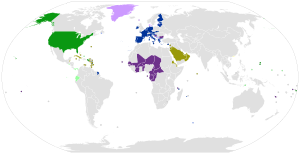
Ascendancy[edit]
The primary currency used for global trade betweenEurope,Asia,andthe Americashas historically been the Spanish-Americansilver dollar,which created a globalsilver standardsystem from the 16th to 19th centuries, due to abundant silver supplies inSpanish America.[71] The U.S. dollar itself was derived from this coin. TheSpanish dollarwas later displaced by the Britishpound sterlingin the advent of the internationalgold standardin the last quarter of the 19th century.
The U.S. dollar began to displace thepound sterlingas internationalreserve currencyfrom the 1920s since it emerged from theFirst World Warrelatively unscathed and since theUnited Stateswas a significant recipient of wartime gold inflows.[72] After the U.S. emerged as an even stronger globalsuperpowerduring theSecond World War,theBretton Woods Agreementof 1944 established the post-war international monetary system, with the U.S. dollar ascending to become the world's primaryreserve currencyfor international trade, and the only post-war currency linked to gold at $35 pertroy ounce.[73]
As international reserve currency[edit]
The U.S. dollar is joined by the world's other major currencies – theeuro,pound sterling,Japanese yenand Chineserenminbi– in the currency basket of thespecial drawing rightsof theInternational Monetary Fund.Central banks worldwide have huge reserves of U.S. dollars in their holdings and are significant buyers ofU.S. treasury bills and notes.[74]
Foreign companies, entities, and private individuals hold U.S. dollars in foreign deposit accounts calledeurodollars(not to be confused with theeuro), which are outside the jurisdiction of theFederal Reserve System.Private individuals also hold dollars outside the banking system mostly in the form ofUS$100 bills,of which 80% of its supply is held overseas.
TheUnited States Department of the Treasuryexercises considerable oversight over theSWIFT financial transfers network,[75]and consequently has a huge sway on the globalfinancial transactionssystems, with the ability to impose sanctions on foreign entities and individuals.[76]
In the global markets[edit]
The U.S. dollar is predominantly the standard currency unit in which goods are quoted and traded, and with which payments are settled, in the globalcommodity markets.[77]TheU.S. Dollar Indexis an important indicator of the dollar's strength or weakness versus a basket of six foreign currencies.
TheUnited States Governmentis capable of borrowing trillions of dollars from the global capital markets in U.S. dollars issued by theFederal Reserve,which is itself under U.S. government purview, at minimal interest rates, and with virtually zero default risk. In contrast, foreign governments and corporations incapable of raising money in their own local currencies are forced to issue debt denominated in U.S. dollars, along with its consequent higher interest rates and risks of default.[78]The United States's ability to borrow in its own currency without facing a significant balance of payments crisis has been frequently described as itsexorbitant privilege.[79]
A frequent topic of debate is whether thestrong dollar policyof the United States is indeed in America's own best interests, as well as in the best interest of theinternational community.[80]
Currencies fixed to the U.S. dollar[edit]
For a more exhaustive discussion of countries using the U.S. dollar as official or customary currency, or using currencies which are pegged to the U.S. dollar, seeInternational use of the U.S. dollar#Dollarization and fixed exchange ratesandCurrency substitution#US dollar.
Countries using the U.S. dollar as their official currency include:
- In the Americas:Panama,Ecuador,El Salvador,British Virgin Islands,Turks and Caicos Islands,and theCaribbean Netherlands.
- The constituent states of the formerTrust Territory of the Pacific Islands:Palau,theFederated States of Micronesia,and theMarshall Islands.
- Others:East Timor.
Among the countries using the U.S. dollar together with other foreign currencies and their local currency areCambodiaandZimbabwe.
Currencies pegged to the U.S. dollar include:
- In the Caribbean: theBahamian dollar,Barbadian dollar,Belize dollar,Bermudian dollar,Cayman Islands dollar,Eastern Caribbean dollar,Netherlands Antillean guilderand theAruban florin.
- The currencies of five oil-producing Arab countries: theSaudi riyal,United Arab Emirates dirham,Omani rial,Qatari riyaland theBahraini dinar.
- Others: theHong Kong dollar,Macanese pataca,Jordanian dinar,Lebanese pound.
Value[edit]
This section needs to beupdated.The reason given is: No new data from the past 12 years (ignoring the difficult to read graphs up to 2021 labeled "Inflation of the dollar" ), but prices of many foods along have increased 2-4x or more as one example, but pay isn't increasing at all for most people. The actual inflation numbers would be interesting..(April 2024) |
|
|
|
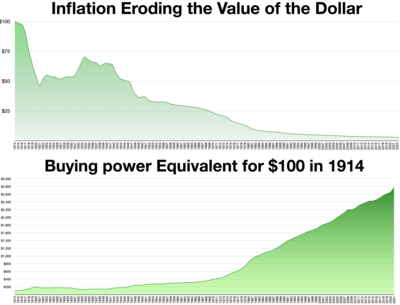
The 6th paragraph ofSection 8of Article 1 of the U.S. Constitution provides that the U.S. Congress shall have the power to "coin money" and to "regulate the value" of domestic and foreign coins. Congress exercised those powers when it enacted theCoinage Act of 1792.That Act provided for the minting of thefirst U.S. dollarand it declared that the U.S. dollar shall have "the value of aSpanish milled dollaras the same is now current ".[81]
The table above shows the equivalent amount of goods that, in a particular year, could be purchased with $1. The table shows that from 1774 through 2012 the U.S. dollar has lost about 97.0% of its buying power.[82]
The decline in the value of the U.S. dollar corresponds toprice inflation,which is a rise in the general level of prices of goods and services in an economy over a period of time.[83]Aconsumer price index(CPI) is a measure estimating the average price of consumer goods and services purchased by households. TheUnited States Consumer Price Index,published by theBureau of Labor Statistics,is a measure estimating the average price of consumer goods and services in the United States.[84]It reflects inflation as experienced by consumers in their day-to-day living expenses.[85]A graph showing the U.S. CPI relative to 1982–1984 and the annual year-over-year change in CPI is shown at right.
The value of the U.S. dollar declined significantly during wartime, especially during theAmerican Civil War,World War I, and World War II.[86]TheFederal Reserve,which was established in 1913, was designed to furnish an "elastic" currency subject to "substantial changes of quantity over short periods", which differed significantly from previous forms ofhigh-powered moneysuch as gold, national banknotes, and silver coins.[87]Over the very long run, the prior gold standard kept prices stable—for instance, the price level and the value of the U.S. dollar in 1914 were not very different from the price level in the 1880s. The Federal Reserve initially succeeded in maintaining the value of the U.S. dollar and price stability, reversing the inflation caused by the First World War and stabilizing the value of the dollar during the 1920s, before presiding over a 30% deflation in U.S. prices in the 1930s.[88]
Under theBretton Woods systemestablished after World War II, the value of gold was fixed to $35 per ounce, and the value of the U.S. dollar was thus anchored to the value of gold. Rising government spending in the 1960s, however, led to doubts about the ability of the United States to maintain this convertibility, gold stocks dwindled as banks and international investors began to convert dollars to gold, and as a result, the value of the dollar began to decline. Facing an emergingcurrency crisisand the imminent danger that the United States would no longer be able to redeem dollars for gold, gold convertibility was finally terminated in 1971 byPresident Nixon,resulting in the "Nixon shock".[89]
The value of the U.S. dollar was therefore no longer anchored to gold, and it fell upon the Federal Reserve to maintain the value of the U.S. currency. The Federal Reserve, however, continued to increase the money supply, resulting instagflationand a rapidly declining value of the U.S. dollar in the 1970s. This was largely due to the prevailing economic view at the time that inflation and real economic growth were linked (thePhillips curve), and so inflation was regarded as relatively benign.[89]Between 1965 and 1981, the U.S. dollar lost two thirds of its value.[82]
In 1979,President CarterappointedPaul VolckerChairman of the Federal Reserve.The Federal Reserve tightened the money supply and inflation was substantially lower in the 1980s, and hence the value of the U.S. dollar stabilized.[89]
Over the thirty-year period from 1981 to 2009, the U.S. dollar lost over half its value.[82]This is because the Federal Reserve has targeted not zero inflation, but a low, stable rate of inflation—between 1987 and 1997, the rate of inflation was approximately 3.5%, and between 1997 and 2007 it was approximately 2%. The so-called "Great Moderation"of economic conditions since the 1970s is credited to monetary policy targeting price stability.[90]
There is an ongoing debate about whether central banks should target zero inflation (which would mean a constant value for the U.S. dollar over time) or low, stable inflation (which would mean a continuously but slowly declining value of the dollar over time, as is the case now). Although some economists are in favor of a zero inflation policy and therefore a constant value for the U.S. dollar,[88]others contend that such a policy limits the ability of the central bank to controlinterest ratesand stimulate the economy when needed.[91]
Pegged currencies[edit]
- Aruban florin(lower value)
- Bahamian dollar(at par)
- Bahraini dinar(higher value)
- Barbadian dollar(lower value)
- Belarusian ruble(alongside Euro and Russian ruble in currency basket)
- Belize dollar(lower value)
- Bermudian dollar(at par)
- Bolivian boliviano(lower value)
- Cambodian riel(lower value)
- Cayman Islands dollar(higher value)
- Costa Rican colón(lower value)
- Cuban peso(lower value)
- Eastern Caribbean dollar(lower value)
- East Timor centavo coins(at par)
- Ecuadorian centavo coins(at par)
- Salvadoran colón(lower value)
- Eritrean nakfa(lower value)
- Guatemalan quetzal(lower value)
- Haitian gourde(lower value)
- Honduran lempira(lower value)
- Hong Kong dollar(narrow band)
- Iraqi dinar(lower value)
- Jordanian dinar(higher value)
- Kuwaiti dinar(higher value)
- Lebanese pound(lower value)
- Netherlands Antillean guilder(lower value, scheduled to be abolished in 2025)
- Nicaraguan córdoba(lower value)
- Nigerian naira(lower value)
- Omani rial(higher value)
- Panamanian balboa(at par)
- Qatari riyal(lower value)
- Saudi riyal(lower value)
- Sierra Leonean leone(lower value)
- Trinidad and Tobago dollar(lower value)
- United Arab Emirates dirham(lower value)
- Yemeni rial(lower value)
- Zimbabwean bond coinsandbond notes(at par)
Exchange rates[edit]

Historical exchange rates[edit]
| Currency units | 1970[i] | 1980[i] | 1985[i] | 1990[i] | 1993 | 1999 | 2000 | 2001 | 2002 | 2003 | 2004 | 2005 | 2006 | 2007 | 2008 | 2009 | 2010 | 2011 | 2012 | 2013 | 2014 | 2015 | 2018[96] |
|---|---|---|---|---|---|---|---|---|---|---|---|---|---|---|---|---|---|---|---|---|---|---|---|
| Euro | — | — | — | — | — | 0.9387 | 1.0832 | 1.1171 | 1.0578 | 0.8833 | 0.8040 | 0.8033 | 0.7960 | 0.7293 | 0.6791 | 0.7176 | 0.6739 | 0.7178 | 0.7777 | 0.7530 | 0.7520 | 0.9015 | 0.8504 |
| Japanese yen | 357.6 | 240.45 | 250.35 | 146.25 | 111.08 | 113.73 | 107.80 | 121.57 | 125.22 | 115.94 | 108.15 | 110.11 | 116.31 | 117.76 | 103.39 | 93.68 | 87.78 | 79.70 | 79.82 | 97.60 | 105.74 | 121.05 | 111.130 |
| Pound sterling | 8s4d =0.4167 |
0.4484[ii] | 0.8613[ii] | 0.6207 | 0.6660 | 0.6184 | 0.6598 | 0.6946 | 0.6656 | 0.6117 | 0.5456 | 0.5493 | 0.5425 | 0.4995 | 0.5392 | 0.6385 | 0.4548 | 0.6233 | 0.6308 | 0.6393 | 0.6066 | 0.6544 | 0.7454 |
| Swiss franc | 4.12 | 1.68 | 2.46[97] | 1.39 | 1.48 | 1.50 | 1.69 | 1.69 | 1.62 | 1.40 | 1.24 | 1.15 | 1.29 | 1.23 | 1.12 | 1.08 | 1.03 | 0.93 | 0.93 | 0.90 | 0.92 | 1.00 | 0.98 |
| Canadian dollar[98] | 1.081 | 1.168 | 1.321 | 1.1605 | 1.2902 | 1.4858 | 1.4855 | 1.5487 | 1.5704 | 1.4008 | 1.3017 | 1.2115 | 1.1340 | 1.0734 | 1.0660 | 1.1412 | 1.0298 | 0.9887 | 0.9995 | 1.0300 | 1.1043 | 1.2789 | 1.2842 |
| Mexican peso[99] | 0.01250–0.02650[iii] | 2.80[iii] | 2.67[iii] | 2.50[iii] | 3.1237 | 9.553 | 9.459 | 9.337 | 9.663 | 10.793 | 11.290 | 10.894 | 10.906 | 10.928 | 11.143 | 13.498 | 12.623 | 12.427 | 13.154 | 12.758 | 13.302 | 15.837 | 19.911 |
| Chinese Renminbi[100] | 2.46 | 1.7050 | 2.9366 | 4.7832 | 5.7620 | 8.2783 | 8.2784 | 8.2770 | 8.2771 | 8.2772 | 8.2768 | 8.1936 | 7.9723 | 7.6058 | 6.9477 | 6.8307 | 6.7696 | 6.4630 | 6.3093 | 6.1478 | 6.1620 | 6.2840 | 6.383 |
| Pakistani rupee | 4.761 | 9.9 | 15.9284 | 21.707 | 28.107 | 51.9 | 51.9 | 63.5 | 60.5 | 57.75 | 57.8 | 59.7 | 60.4 | 60.83 | 67 | 80.45 | 85.75 | 88.6 | 90.7 | 105.477 | 100.661 | 104.763 | 139.850 |
| Singapore dollar | — | — | 2.179 | 1.903 | 1.6158 | 1.6951 | 1.7361 | 1.7930 | 1.7908 | 1.7429 | 1.6902 | 1.6639 | 1.5882 | 1.5065 | 1.4140 | 1.4543 | 1.24586 | 1.2565 | 1.2492 | 1.2511 | 1.2665 | 1.3748 | 1.343 |
| South Korean won | 310.556 | 607.717 | 870.020 | 707.766 | 802.538 | 1189.439 | 1130.362 | 1290.790 | 1251.602 | 1191.646 | 1146.249 | 1024.328 | 955.341 | 929.376 | 1100.126 | 1277.246 | 1156.460 | 1108.233 | 1126.807 | 1094.983 | 1052.840 | 1130.953 | 1100.163 |
Current exchange rates[edit]
| Current USD exchange rates | |
|---|---|
| FromGoogle Finance: | AUDCADCHFCNYEURGBPHKDJPYCADTWDKRW |
| FromYahoo! Finance: | AUDCADCHFCNYEURGBPHKDJPYCADTWDKRW |
| FromXE.com: | AUDCADCHFCNYEURGBPHKDJPYCADTWDKRW |
| From OANDA: | AUDCADCHFCNYEURGBPHKDJPYCADTWDKRW |
See also[edit]
- Counterfeit United States currency
- Dedollarisation
- Currency substitution
- International use of the U.S. dollar
- List of the largest trading partners of the United States
- Monetary policy of the United States
- Petrodollar recycling
- Strong dollar policy
- U.S. Dollar Index
- Virtual currency
Notes[edit]
- ^Silver bullion can be converted in unlimited quantities of Trade dollars of 420 grains, but these were meant for export and had legal tender limits in the US. SeeTrade dollar (United States coin).
- ^Obverse
- ^Reverse
- ^SeeFederal Reserve Note § Lawsuit over U.S. banknote designfor details and references.
- ^abcdMexican peso values prior to 1993 revaluation
- ^ab1970–1992ArchivedOctober 23, 2018, at theWayback Machine.1980derived from AUD–USD=1.1055 and AUD–GBP=0.4957 at end of Dec 1979: 0.4957/1.1055=0.448394392;1985derived from AUD–USD=0.8278 and AUD–GBP=0.7130 at end of Dec 1984: 0.7130/0.8278=0.861319159.
- ^abcdValue at the start of the year
References[edit]
- ^"Coinage Act of 1792"(PDF).United States Congress.Archived fromthe original(PDF)on April 7, 2004.RetrievedApril 2,2008.
- ^"Nixon Ends Convertibility of US Dollars to Gold and Announces Wage/Price Controls".Federal Reserve Bank of Richmond.Archivedfrom the original on November 20, 2020.RetrievedOctober 17,2018.
- ^"The Implementation of Monetary Policy – The Federal Reserve in the International Sphere"(PDF).Archived(PDF)from the original on April 27, 2017.RetrievedOctober 17,2018.
- ^Cohen, Benjamin J. 2006.The Future of Money,Princeton University Press.ISBN0-691-11666-0.
- ^Agar, Charles. 2006.Vietnam,(Frommer's).ISBN0-471-79816-9.p. 17: "the dollar is the de facto currency in Cambodia."
- ^"How much U.S. currency is in circulation?".Federal Reserve.Archivedfrom the original on November 13, 2021.RetrievedFebruary 27,2021.
- ^"Federal Reserve Balance Sheet: Factors Affecting Reserve Balances - H.4.1".September 21, 2023. Archived fromthe originalon October 4, 2023.
- ^U.S. Constitution, Article 1, Section 8.para. 5ArchivedNovember 18, 2021, at theWayback Machine.
- ^abcDenominations, specifications, and design of coins.31 U.S.C.§ 5112.
- ^U.S. Constitution, Article 1, Section 9.para. 7ArchivedNovember 18, 2021, at theWayback Machine.
- ^Reports.31 U.S.C.§ 331.
- ^"Financial Report of the United States Government"(PDF).Department of the Treasury. 2009. Archived fromthe original(PDF)on November 13, 2018.RetrievedOctober 17,2018.
- ^abU.S. Congress.1792.Coinage Act of 1792.2nd Congress,1st Session. Sec. 9, ch. 16. Retrieved June 6, 2020.
- ^abFitzpatrick, John C., ed. (1934)."Tuesday, August 8, 1786".Journals of the Continental Congress 1774–1789.XXXI: 1786: 503–505.Archivedfrom the original on May 7, 2021.RetrievedDecember 5,2019.
- ^Peters, Richard, ed. (1845)."Second Congress. Sess. I. Ch. 16".The Public Statutes at Large of the United States of America, Etc. Etc.1:246–251.Archivedfrom the original on November 13, 2020.RetrievedDecember 5,2019.
- ^Langland, Connie (May 27, 2015)."What is a millage rate and how does it affect school funding?".WHYY.PBS and NPR.Archivedfrom the original on March 7, 2021.RetrievedDecember 5,2019.
- ^ab"Mills Currency".Past & Present.Stamp and Coin Place Blog. September 26, 2018. Archived fromthe originalon May 3, 2021.RetrievedDecember 5,2019.
- ^ab"How much is" two bits "and where did the phrase".Archivedfrom the original on August 14, 2021.RetrievedJune 9,2021.
- ^"Decimal Trading Definition and History".Archivedfrom the original on November 18, 2021.RetrievedJune 10,2021.
- ^Mehl, B. Max. "United States $50.00 Gold Pieces, 1877", inStar Rare Coins Encyclopedia and Premium Catalogue(20th edition, 1921)
- ^ab"Ask US."National Geographic.June 2002. p. 1.
- ^There is no solid reference on the desirability of liondollars in North America and on 1:1 parity with heavier dollars. A dollar worth $0.80 Spanish is not cheap if priced at $0.50http://coins.lakdiva.org/netherlands/1644_wes_lion_daalder_ag.htmlArchivedFebruary 5, 2013, at theWayback Machinehttps://coins.nd.edu/ColCoin/ColCoinIntros/Lion-Dollar.intro.htmlArchivedJuly 10, 2018, at theWayback Machine
- ^"Buck".Online Etymology Dictionary.RetrievedOctober 17,2018.
- ^"Paper Money Glossary".Littleton Coin Company. Archived fromthe originalon October 18, 2018.RetrievedOctober 17,2018.
- ^Scutt, David (June 3, 2019)."The Australian dollar is grinding higher as expectations for rate cuts from the US Federal Reserve build".Business Insider.Archived fromthe originalon August 7, 2019.RetrievedAugust 7,2019.
- ^Tappe, Anneken (August 9, 2018)."New Zealand dollar leads G-10 losers as greenback gains strength".MarketWatch.Archivedfrom the original on August 7, 2019.RetrievedAugust 7,2019.
- ^"UPDATE 1-South Africa's rand firms against greenback, stocks rise".Reuters.RetrievedAugust 7,2019.[dead link]
- ^"Why rupee is once again under pressure".Business Today.April 22, 2019.RetrievedAugust 7,2019.[permanent dead link]
- ^Cajori, Florian([1929]1993).A History of Mathematical Notations(Vol. 2). New York: Dover, 15–29.ISBN0-486-67766-4
- ^Aiton, Arthur S.; Wheeler, Benjamin W. (1931)."The First American Mint".The Hispanic American Historical Review.11(2). p. 198 and note 2 on p. 198.doi:10.1215/00182168-11.2.198.ISSN0018-2168.JSTOR2506275.
- ^Nussbaum, Arthur(1957).A History of the Dollar.New York: Columbia University Press. p.56.
The dollar sign, $, is connected with the peso, contrary to popular belief, which considers it to be an abbreviation of 'U.S.' The two parallel lines represented one of the many abbreviations of 'P,' and the 'S' indicated the plural. The abbreviation '$.' was also used for the peso, and is still used in Argentina.
- ^"U.S. Bureau of Engraving and Printing – FAQs".www.bep.gov.Archived fromthe originalon October 18, 2018.RetrievedOctober 17,2018.
- ^Rand, Ayn. [1957] 1992.Atlas Shrugged.Signet.p. 628.
- ^James, James Alton (1970) [1937].Oliver Pollock: The Life and Times of an Unknown Patriot.Freeport: Books for Libraries Press. p. 356.ISBN978-0-8369-5527-9.
- ^Mint, U.S. (April 6, 2017)."Coinage Act of 1792".U.S. treasury.Archivedfrom the original on November 8, 2020.RetrievedOctober 17,2018.
- ^Mason, Seth (January 7, 2013)."The Definitive Inflation Chart".Ecominoes.Archivedfrom the original on October 19, 2018..
- ^Sumner, W. G. (1898)."The Spanish Dollar and the Colonial Shilling".The American Historical Review.3(4): 607–619.doi:10.2307/1834139.JSTOR1834139.Archivedfrom the original on April 9, 2022.RetrievedJune 7,2021.
- ^"United States Dollar".OANDA.Archivedfrom the original on October 18, 2018.RetrievedOctober 17,2018.
- ^"Engraving and printing currency and security documents:Article b".Legal Information Institute.Archivedfrom the original on December 20, 2013.RetrievedDecember 19,2013.
- ^Matt Soniak (July 22, 2011)."On the Money: Everything You Ever Wanted to Know About Coin Portraits".Mental Floss.RetrievedOctober 17,2018.
- ^Newman, Eric P. (1990).The Early Paper Money of America(3 ed.). Iola, Wisconsin: Krause Publications. p. 17.ISBN0-87341-120-X.
- ^Wright, Robert E. (2008).One Nation Under Debt: Hamilton, Jefferson, and the History of What We Owe.New York, New York: McGraw-Hill. pp. 50–52.ISBN978-0-07-154393-4.
- ^Anderson, Gordon T. April 25, 2005. "Congress tries again for a dollar coinArchivedMarch 21, 2022, at theWayback Machine."CNN Money.
- ^Christian Zappone (July 18, 2006)."Kill-the-penny bill introduced".CNN Money.Archivedfrom the original on July 28, 2019.RetrievedOctober 17,2018.
- ^Weinberg, Ali (February 19, 2013)."Penny pinching: Can Obama manage elimination of one-cent coin?".NBC News.Archivedfrom the original on October 18, 2018.RetrievedOctober 17,2018.
- ^Gibbs, William T. (June 29, 2023)."Series 2021 dollar notes now being found in circulation".Coin World.RetrievedApril 26,2024.
- ^Meyersohn, Nathaniel (September 20, 2022)."Why it's time to start paying with $2 bills".CNN.RetrievedFebruary 6,2024.
- ^"5 Dollars (Federal Reserve Note; colored) - United States".Archivedfrom the original on June 7, 2023.RetrievedJune 7,2023.
- ^"$100 Note | U.S. Currency Education Program".Archivedfrom the original on August 20, 2020.RetrievedApril 22,2021.
- ^"Paragraph 2 of Section 8 of Article 1 of the United States Constitution".Topics.law.cornell.edu.Archivedfrom the original on November 18, 2021.RetrievedOctober 17,2018.
- ^"Section 411 of Title 12 of the United States Code".Law.cornell.edu. June 22, 2010.Archivedfrom the original on June 27, 2019.RetrievedOctober 17,2018.
- ^"Section 5103 of Title 31 of the United States Code".Law.cornell.edu. August 6, 2010.Archivedfrom the original on October 22, 2018.RetrievedOctober 17,2018.
- ^"Section 5115 of Title 31 of the United States Code".Law.cornell.edu. August 6, 2010.Archivedfrom the original on June 27, 2019.RetrievedOctober 17,2018.
- ^"Treasury Department Appropriation Bill for 1929: Hearing Before the Subcommittee of House Committee on Appropriations... Seventieth Congress, First Session".1928.
- ^Schwarz, John; Lindquist, Scott (September 21, 2009).Standard Guide to Small-Size U.S. Paper Money – 1928-Date.Penguin.ISBN9781440225789.
- ^Orzano, Michele (February 25, 2015)."What is a horse blanket note?".Coin World.Archivedfrom the original on November 29, 2021.
- ^"Central Bank of Timor-Leste".Archivedfrom the original on May 1, 2019.RetrievedMarch 22,2017.
The official currency of Timor-Leste is the United States dollar, which is legal tender for all payments made in cash.
- ^"Ecuador".CIA World Factbook.October 18, 2010.Archivedfrom the original on January 10, 2021.RetrievedOctober 17,2018.
The dollar is legal tender
- ^"El Salvador".CIA World Factbook.October 21, 2010.Archivedfrom the original on May 7, 2021.RetrievedOctober 17,2018.
The US dollar became El Salvador's currency in 2001
- ^"Currency".Central Bank of Liberia.Archivedfrom the original on January 15, 2023.RetrievedJanuary 15,2023.
- ^"How the US Dollar Became a Popular Currency in Argentina".Anthropology@Princeton.RetrievedMay 13,2024.
- ^Nay Im, Tal; Dabadie, Michel (March 31, 2007)."Dollarization in Cambodia"(PDF).National Bank of Cambodia.Archived(PDF)from the original on May 11, 2022.RetrievedApril 11,2022.
- ^Nagumo, Jada (August 4, 2021)."Cambodia aims to wean off US dollar dependence with digital currency".Nikkei Asia.Archivedfrom the original on April 15, 2022.RetrievedApril 11,2022.
Cambodia runs a dual-currency system, with the U.S. dollar widely circulating in its economy. The country's dollarization began in the 1980s and 90s, following years of civil war and unrest.
- ^Zerpa, Fabiola (November 5, 2019)."Venezuela Is Now More Than 50% Dollarized, Study Finds".Bloomberg.RetrievedNovember 9,2019.
- ^"Maduro says 'thank God' for dollarization in Venezuela".Reuters.November 17, 2019.RetrievedNovember 18,2019.
- ^Rivera, Juan Carlos (November 23, 2023)."Roatán prefiere cobrar en dólares o lempiras; no bitcóin"[Roatán prefers to charge in dollars or lempiras; not bitcoin].laprensa.hn(in Spanish).La Prensa.RetrievedJuly 12,2024.
- ^"Federal Reserve Board – Purposes & Functions".Archivedfrom the original on March 26, 2020.RetrievedJune 11,2021.
- ^"Conducting Monetary Policy"(PDF).United States Federal Reserve.Archived(PDF)from the original on August 11, 2021.RetrievedAugust 23,2021.
- ^"St. Louis Adjusted Monetary Base".Federal Reserve Bank of St. Louis.February 15, 1984.Archivedfrom the original on October 17, 2018.RetrievedOctober 17,2018.
- ^"Fact Sheets: Currency & Coins".United States Department of the Treasury.Archivedfrom the original on October 18, 2018.RetrievedOctober 17,2018.
- ^"'The Silver Way' Explains How the Old Mexican Dollar Changed the World ".April 30, 2017.Archivedfrom the original on May 16, 2021.RetrievedJune 8,2021.
- ^Eichengreen, Barry; Flandreau, Marc (2009)."The rise and fall of the dollar (or when did the dollar replace sterling as the leading reserve currency?)".European Review of Economic History.13(3): 377–411.doi:10.1017/S1361491609990153.ISSN1474-0044.S2CID154773110.Archivedfrom the original on January 7, 2023.RetrievedApril 16,2021.
- ^"How a 1944 Agreement Created a New World Order".Archivedfrom the original on May 20, 2021.RetrievedJune 8,2021.
- ^"MAJOR FOREIGN HOLDERS OF TREASURY SECURITIES".US Treasury.March 15, 2023.Archivedfrom the original on November 23, 2010.RetrievedMay 22,2023.
- ^"SWIFT oversight".Archivedfrom the original on June 16, 2023.RetrievedJune 8,2021.
- ^"Sanctions Programs and Country Information | U.S. Department of the Treasury".Archivedfrom the original on June 16, 2023.RetrievedJune 8,2021.
- ^"Impact of the Dollar on Commodity Prices".Archivedfrom the original on March 1, 2023.RetrievedJune 8,2021.
- ^"Dollar Bond".Archivedfrom the original on June 8, 2021.RetrievedJune 8,2021.
- ^Bernanke, Ben S. (January 7, 2016)."The dollar's international role: An" exorbitant privilege "?".Archivedfrom the original on June 8, 2021.
- ^Mohsin, Saleha (January 21, 2021)."The Strong Dollar".Bloomberg.Archivedfrom the original on August 22, 2021.RetrievedAugust 23,2021.
- ^"Section 9 of the Coinage Act of 1792".American Memory - Library of Congress.Archivedfrom the original on July 29, 2020.RetrievedAugust 24,2010.
- ^abc"Measuring Worth – Purchasing Power of Money in the United States from 1774 to 2010".Archivedfrom the original on June 16, 2023.RetrievedApril 22,2010.
- ^Olivier Blanchard(2000).Macroeconomics(2nd ed.), Englewood Cliffs, N.J: Prentice Hall,ISBN0-13-013306-X
- ^"Consumer Price Index Frequently Asked Questions".Archivedfrom the original on October 18, 2018.RetrievedOctober 16,2018.
- ^"Consumer Price Index Frequently Asked Questions".Archivedfrom the original on October 18, 2018.RetrievedOctober 17,2018.
- ^Milton Friedman,Anna Jacobson Schwartz(November 21, 1971).A monetary history of the United States, 1867–1960.p. 546.ISBN978-0691003542.
- ^Friedman 189–190
- ^abBroaddus Jr., J. Alfred (September 1, 1993)."Central Banking—Then and Now".Federal Reserve Bank of Minneapolis.Archived fromthe originalon October 26, 2018.RetrievedOctober 17,2018.
- ^abcEmery, Kenneth M."Controlling Inflation: A Historical Perspective"(PDF).Federal Reserve Bank of Dallas. Archived fromthe original(PDF)on December 7, 2010.RetrievedJuly 17,2010.
- ^Ferguson, Roger W. Jr. (November 3, 2005)."Monetary Credibility, Inflation, and Economic Growth".FRB.Archivedfrom the original on August 15, 2010.RetrievedJuly 17,2010.
- ^"What are the goals of U.S. monetary policy?".Federal Reserve Bank of San Francisco.February 6, 2004. Archived fromthe originalon October 18, 2018.RetrievedOctober 17,2018.
- ^U.S. Federal Reserve:Last 4 yearsArchivedOctober 18, 2018, at theWayback Machine,2009–2012ArchivedOctober 18, 2018, at theWayback Machine,2005–2008ArchivedOctober 18, 2018, at theWayback Machine,2001–2004ArchivedOctober 18, 2018, at theWayback Machine,1997–2000ArchivedOctober 18, 2018, at theWayback Machine,1993–1996ArchivedOctober 18, 2018, at theWayback Machine; Reserve Bank of Australia:1970–presentArchivedOctober 23, 2018, at theWayback Machine
- ^"2004–present".Archivedfrom the original on July 23, 2014.RetrievedJuly 24,2014.
- ^"FRB: Foreign Exchange Rates – G.5A; Release Dates".Board of Governors of the Federal Reserve System.Archivedfrom the original on August 3, 2014.RetrievedJuly 23,2014.
- ^"Exchange rates".OECD.
- ^"Historical Exchange Rates Currency Converter".TransferMate.com.Archivedfrom the original on September 18, 2016.RetrievedSeptember 10,2016.
- ^"Exchange Rates Between the United States Dollar and the Swiss FrancArchivedMarch 30, 2019, at theWayback Machine."Measuring Worth. Retrieved October 17, 2018.
- ^1977–1991
- ^1976–1991
- ^1974–1991, 1993–1995
Further reading[edit]
- Prasad, Eswar S. (2014).The Dollar Trap: How the U.S. Dollar Tightened Its Grip on Global Finance.Princeton, NJ:Princeton University Press.ISBN978-0-691-16112-9.
External links[edit]
- U.S. Bureau of Engraving and PrintingArchivedMay 30, 1997, at theWayback Machine
- U.S. Currency and Coin Outstanding and in Circulation
- American Currency Exhibit at the San Francisco Federal Reserve Bank
- Relative values of the U.S. dollar, from 1774 to present
- Historical Currency Converter
- Summary of BEP Production Statistics
- The U.S. Currency Education Program
Images of U.S. currency and coins[edit]
- Currencies with ISO 4217 code
- Currencies of Africa
- Circulating currencies
- Currencies of Asia
- Currencies of Oceania
- Dollar
- United States dollar
- Currencies introduced in 1792
- Currencies of British Overseas Territories
- Currencies of East Timor
- Currencies of Ecuador
- Currencies of El Salvador
- Currencies of the Kingdom of the Netherlands
- Currencies of the United States
- Currencies of Zimbabwe
- Historical currencies of the United States
- 1792 establishments in the United States


